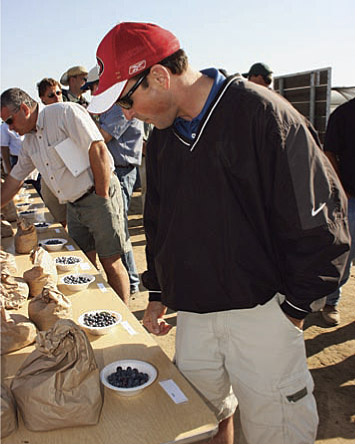All Issues
Solutions sought to protect valuable blueberries from citrus thrips
Publication Information
California Agriculture 62(3):90-90.
Published June 01, 2008
PDF | Citation | Permissions
Full text
Greg Paganelli, of Washington, tastes a blueberry variety (‘Rebel’) picked that morning from the Kearney fields during a May field day.
After blueberry growers in the San Joaquin Valley reported that citrus thrips were causing extensive damage to their crops, a research team led by UC Cooperative Extension farm advisor David Haviland developed monitoring and treatment guidelines to help growers avoid using unnecessary pesticides.
In 2006, Haviland and his research team began a 3-year study of citrus thrips damage to blueberries with funding from the UC Statewide Integrated Pest Management Program.
“Citrus thrips are best known for the scarring damage they cause to navel oranges in the San Joaquin Valley, but with the recent plantings of blueberries, this pest has taken damage to a whole new level,” Haviland says.
UC blueberry researchers estimate that California has more than 4,500 acres of commercial blueberry plantings (see page 91). Most early blueberry acreage planted in California is on smaller farms, while larger parcels are currently being converted.
Managing thrips
Haviland says that management of citrus thrips is critical, given the high value of blueberries and potential damage in the thousands of dollars per acre. “Current practices are to spray fields multiple times with insecticide after harvest through fall. However, with the propensity of citrus thrips to develop resistance to insecticides, and spinosyn-based insecticides being the only effective products registered for blueberries, alternate approaches are needed.”
Unlike flower thrips, which prefer to feed within blossoms, citrus thrips prefer new growth. This makes blueberries an excellent host because they produce new, tender growth at the end of their shoots from June through October.
Citrus thrips feeding on blueberry foliage results in a wide range of symptoms including crinkled or misshapen leaves, stem scarring, stem discoloration, shortened internodes and death of the shoot tip. In some cases, death of the tip causes the buds at the bases of leaves to begin to grow, giving the shoot the appearance of an upside-down witch's broom.
Haviland and his team showed that an average of 35 thrips on a shoot tip for a 1-month period in August caused a 52% reduction in the length of new shoots. However, damage didn't stop there. Blueberry fruit during the spring develops at the tips of the shoots from the previous year. This means that citrus thrips feeding causes reduced growth that results in less fruiting wood, and, therefore, less fruit.
Harvest data confirmed that for every 10 citrus thrips per shoot tip over a 1-month period in August 2006, there was a 5.3% reduction in yield at harvest in 2007. For the field where the research took place, this was the equivalent of an 18.4% yield loss in the untreated fruit.
The UC team is developing an IPM program for this destructive pest. To date, they have developed information on the seasonal biology of citrus thrips in blueberries, a monitoring program and treatment guidelines. They are also investigating alternatives to insecticides, such as the repeated use of high-pressure water to knock immature thrips off of the plants, and the use of Beauveria bassiana, a parasitic fungus that acts as on the pupal stage of thrips that reside in the soil.
Competition in a new market
With more blueberry acreage coming into production, a series of blueberry-themed workshops and field days was held in May in the Central Coast, South Coast and Central Valley. The events were aimed at introducing this specialty crop to growers, and planning for increased market competition.
UC farm advisors say that methods for staying competitive in the blueberry market will vary by region.
“Growers need to realize that added acreage some place else means more competition and possibly fewer places to sell our blueberries,” says Manuel Jimenez, UC Small Farm Program advisor in Tulare County.
“Even though demand continues to go up, I think the supply on our side has been going up very, very fast in a short period of time. All that new blueberry acreage is coming into production now.”






